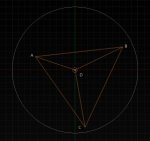This is a problem I am trying to solve for an engineering situation, but I am also very interested to learn the process involved to solve this problem.
My goal is to determine the diameter of a sphere using only the Y coordinates of three points of a tetrahedron. Below is an image showing an example.

The tetrahedron is formed by drawing three perpendicular lines from the center of a sphere to the edges of the sphere. The angle of this tetrahedron is unknown. All I am provided is the Y coordinates relative to the green vertical line of point A, B, and C. Point D is always (0,0).
Here is an example of coordinate data I am receiving: A = -23, B = -174, C = -466. This makes up three points directly related to the Y axis, so my interest is in knowing the size of the sphere contained in it.
My initial thought on how to tackle this problem is to use Euler angles in some way, unfortunately I'm lost on how to go about that for this kind of situation.
Thank you in advance for your help!
My goal is to determine the diameter of a sphere using only the Y coordinates of three points of a tetrahedron. Below is an image showing an example.

The tetrahedron is formed by drawing three perpendicular lines from the center of a sphere to the edges of the sphere. The angle of this tetrahedron is unknown. All I am provided is the Y coordinates relative to the green vertical line of point A, B, and C. Point D is always (0,0).
Here is an example of coordinate data I am receiving: A = -23, B = -174, C = -466. This makes up three points directly related to the Y axis, so my interest is in knowing the size of the sphere contained in it.
My initial thought on how to tackle this problem is to use Euler angles in some way, unfortunately I'm lost on how to go about that for this kind of situation.
Thank you in advance for your help!
